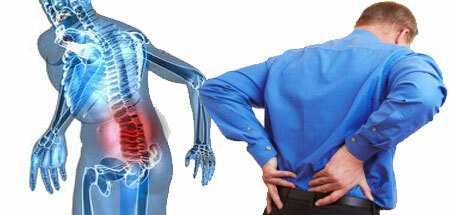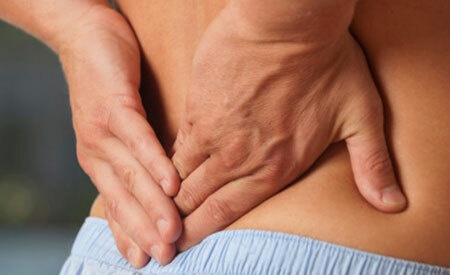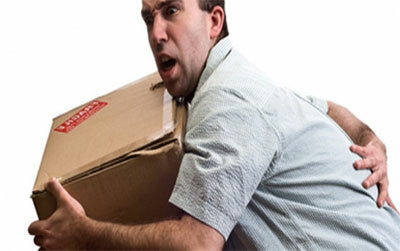"Witch's chamber"( Hexenschuss, Witch Shot) - this is how we called acute spontaneous pains in the zone of the lumbar spine of our ancient ancestors. But, what is it? Lumbago is an acute disorder of a discogenic nature that occurs against the background of degenerative processes occurring in the vertebrae and intervertebral discs of the spine.
The development of lumbago is always the same, regardless of any reason. A strong shooting pain and spasm in the muscles surrounding the spine are caused by the excitation of a huge number of nerve roots located on the outer part of the intervertebral discs and on the surrounding vertebrae ligaments.

This process occurs due to deformation or displacement of the intervertebral discs, or vertebrae themselves. A large number of factors contribute to the manifestation of the lumbar lumbar region, the main ones are:
- Damage to the structure of the intervertebral discs due to heavy loads( tearing of the fibrous ring, or the exit of the nucleus beyond its limits).
- Supernova of vertebral ligaments.
- Congenital anomalies( splitting of vertebral disks, additional, or reduction of vertebrae or their fusion, in the lumbar or sacral region of the spine).
- Change in the anatomical configuration of the intervertebral joints and the vertebra itself( wedge-shaped or butterfly-shaped).
- Congenital spondylolisthesis.
- Vascular tumors, benign and malignant formations.
- Metastases from other formations.
- Infections causing inflammatory reactions in the vertebrae.
- Rheumatic pathologies.
With the formation of bone growths( osteophytes), due to the long-term lumbar osteochondrosis, lumbago is a common manifestation.
Contents
- 1 Symptoms of lumbago
- 2 Diagnostic examination of lumbago
- 3 Methods for treating lumbago, drugs
- 4 Prevention measures for lumbago
Symptoms of lumbago

The most acute symptoms of lumbago are experienced by young and middle-aged people. Muscle spasm and lumbago of acute pain finds them in the process of loading, or after them, with a sharp temperature drop, for example - a hot sauna and a cold pool.
The main signs of lumbago are manifested:
1) Pain syndrome
Attacks of pains are intense, vomiting, impulsive, shooting character. A very acute pain is noted within half an hour after the onset of the attack. Sometimes it lasts for hours, abating, again sharply manifested at night. Usually a week later, seizures stop, but until they are completely eliminated and recovered, it may take time, almost two months.
Muscular pains in the back are noted, sometimes they radiate to the femoral and gluteal zones, passing to the anterior and posterior surface of the shin. This symptomatology speaks of the development of sciatica. What it is?
Lumbago with sciatica is an infringement or irritation of the nerve structures of the sciatic nerve, which projects the pain syndrome into the heel, shin, knee and hip joint.
The long process of sciatica causes disorders of the cellular circulation in the muscles and skin resulting in dystrophic changes in the nerve fibers, as a result - the development of motor neuropathy of the legs. Muscular strength is lost in the affected limb and lameness develops. In complicated processes, the leg can be covered with trophic ulcers, which require complex treatment.
2) Muscular spasm
The strong tension of the lumbar muscles manifests itself reflexively due to pain symptoms. Sometimes there is a strong tension of the gluteus and thigh muscles.
3) Reduced mobility of the waist

Severe muscular spasm immobilizes the patient, he freezes in a fixed position slightly leaning forward. Attempts to move cause severe pain. Muscles of the waist are tense and dense in structure.
Movement in the loin is blocked, flexion and extensor movements are impossible neither independently nor with the help of outsiders.
In bed, the victim takes a forced position - lying on his back, pulls his knees bent at the knees, or lie on his stomach, laying under his pillows. Self-transition to a sitting position is given with great difficulty - with the help of support on the hands.
Today, with symptoms of lumbago, treatment and a modern diagnostic scheme can successfully identify the likely cause of the pathology and choose the best option for its elimination.
Diagnostic examination of lumbago
Diagnosis of lumbago begins with a neurologic examination:
- revealing the nature and intensity of the pain syndrome;
- condition of lower back muscles;
- determines the degree of disturbances in motor and sensory functions;
- appoints a biochemical study and special tests that help determine the nature of pathological processes in the spine.
Further examination is carried out by instrumental diagnostic methods, including:
- X-ray examination - identification of possible injuries, dislocation of discs and vertebrae, congenital anomalies, tumor processes and the presence of signs of osteochondrosis.
- Computer and magnetic resonance imaging - a layered examination of the vertebrae, to determine the degree of their damage, protrusion and destruction of discs. Detection of tumors or fractures.
- Scintigraphic study - identification of the non-involution of vertebral arches, tumor metastases, purulent inflammation and abscesses.
- Electroneuromiogram - detection of compression of nerve fibers and conductive disorders.
For consultations are involved - orthopedist, vertebrologist and neurosurgeon. Such a comprehensive examination helps to form an effective therapy for lumbago treatment.
Methods of treatment of lumbago, preparations

The complex therapy includes various methods of treatment lumbago - medicamentous, physiotherapeutic and alternative. Treatment is carried out in stages. At the first stage, pain symptoms are stopped, then complex therapy begins to eliminate the causative factor.
Medical treatment of lumbago includes:
- Anti-inflammatory and analgesic preparations - Orthofen, Diclogen, Voltaren, Rapten or Rapid and Nurofen in tablet form and in injections( dosage and course are individual).
- The compresses of 50% Dimexide solution on the lumbar zone( up to half an hour twice a day daily) and intradermal novocaine injections of the near-vertebral zone stop the pain and reduce inflammation.
- For the removal of muscle spasm, "Spazmolitin" or "Midokalm" is prescribed, which blocks the nerve endings, thereby relieving spasm. 4) Diuretics, for example, "Furosemide", help to remove puffiness in the area of the nerve roots. And for the normalization of blood circulation is recommended "Trental".
- For lumbago, warming action ointments are strictly prohibited, as they can aggravate the process if the pains are caused by an inflammatory process -
provoke an increase in swelling, and expand the area of lesion of nervous tissues. It's like taking a hot bath at a temperature. Used ointments based on analgesics and anti-inflammatory drugs. A good effect was shown - "Final-gel", "Fastum-gel" and "Voltaren". - Sleeping preparations and tractors( according to indications).
- Restores nerve tissue to vitamin therapy.
The combination of ultraviolet irradiation and gentle manual techniques - amplipulse therapy and dynamic currents, acupressure, hirudotherapy and acupuncture - contribute to the relief of pain symptoms and muscle spasms.
Only after the elimination of pain and muscle tension, the lumbago treatment methods that provoked "Witch's chamber" are used.
The general course of therapy can last up to two months.
Prevention measures lumbago
Prevent the re-emergence of such a painful process will help first of all, attentive to yourself attitude. To exclude the lifting of weights, to alternate physical labor with the mental.
In doing so - more often crush the spine. Find the time for outdoor activities. Do swimming, gymnastics or doing daily exercises to strengthen the lumbar muscles and ligaments.
Remember .Before embarking on independent treatment, it is necessary to know what to treat. To do this, you need to undergo a comprehensive examination. Blocking pain symptoms will not solve the problem, as it does not relieve the cause.



